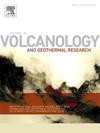Long-term development of lava dome morphology and thermal energy release in the crater of Mount St. Helens, Washington (USA)
IF 2.4
3区 地球科学
Q2 GEOSCIENCES, MULTIDISCIPLINARY
Journal of Volcanology and Geothermal Research
Pub Date : 2025-01-16
DOI:10.1016/j.jvolgeores.2025.108274
引用次数: 0
Abstract
The crater of Mount St. Helens has undergone significant changes since the end of the 2004–2008 eruption cycle. Heat output from the new lava dome has decreased constantly in different phases of cooling. At the same time, the lava dome morphology changed, including substantial subsidence. Herein we present long-term dome evolution within the St. Helens crater by combining field investigations and remote sensing data. Repeated surveys of subglacial caves provide evidence for a new phase of dome cooling and reduced fumarolic activity. While the caves remained consistent or became larger before 2022, the latest field campaigns in 2023 indicated a strong volume reduction. One example is Mothra Cave, which reduced from 797.4 to 189.8 m in surveyed length in one year (2022 to 2023). These observations are supported by decreasing fumarole temperatures in/near the cave systems located at the dome flanks (trending towards 0 °C) as well as decreasing fumarole temperatures at the dome summit (∼380 °C in 2014/2015, ∼90 °C in 2021; ∼60 °C in 2024). Although ASTER data similarly revealed an overall cooling of the lava dome, field investigations enabled a more precise determination of the temperature distribution. As revealed by LiDAR data, the new 2004–2008 lava dome decreased in elevation more than 35 m from 2009 to 2019. In contrast, almost no elevation change was observed at the old 1980–1986 dome. The elevation loss is strongly related to initial dome growth structures. Drone images further characterized structures on the new dome, demonstrating correlations between fumarolic areas and substrate and morphology. Since lava dome degradation is associated with numerous hazards, information about their long-term development as well as the comparison between various parameters and their response time can contribute to hazard forecasts.
美国华盛顿圣海伦斯火山火山口熔岩穹窿形态与热能释放的长期发展
自2004-2008年喷发周期结束以来,圣海伦火山的火山口经历了重大变化。新熔岩穹丘的热量输出在冷却的不同阶段不断减少。与此同时,熔岩穹丘的形态发生了变化,包括大量的下沉。在此,我们通过结合实地调查和遥感数据,提出了圣海伦火山口内长期的圆顶演变。对冰下洞穴的反复调查提供了证据,证明圆顶冷却的新阶段和火山喷发活动的减少。虽然洞穴在2022年之前保持不变或变得更大,但2023年的最新实地调查表明,洞穴数量大幅减少。其中一个例子是Mothra洞穴,在一年内(2022年至2023年),其测量长度从797.4米减少到189.8米。这些观测结果得到了位于圆顶侧翼的洞穴系统内/附近的喷气孔温度下降(趋向于0°C)以及圆顶顶部喷气孔温度下降(2014/2015年为~ 380°C, 2021年为~ 90°C;2024年约60°C)。尽管ASTER数据同样显示了熔岩穹丘的整体冷却,但实地调查能够更精确地确定温度分布。激光雷达数据显示,从2009年到2019年,新的2004-2008年熔岩穹丘海拔下降了35米以上。相比之下,在1980-1986年的老穹顶上几乎没有观察到高度变化。海拔损失与初始圆顶生长结构密切相关。无人机图像进一步表征了新圆顶上的结构,展示了延胡索区域与基质和形态之间的相关性。由于熔岩穹窿退化与许多灾害有关,有关其长期发展的信息以及各种参数之间的比较及其响应时间可以有助于灾害预测。
本文章由计算机程序翻译,如有差异,请以英文原文为准。
求助全文
约1分钟内获得全文
求助全文
来源期刊
CiteScore
5.90
自引率
13.80%
发文量
183
审稿时长
19.7 weeks
期刊介绍:
An international research journal with focus on volcanic and geothermal processes and their impact on the environment and society.
Submission of papers covering the following aspects of volcanology and geothermal research are encouraged:
(1) Geological aspects of volcanic systems: volcano stratigraphy, structure and tectonic influence; eruptive history; evolution of volcanic landforms; eruption style and progress; dispersal patterns of lava and ash; analysis of real-time eruption observations.
(2) Geochemical and petrological aspects of volcanic rocks: magma genesis and evolution; crystallization; volatile compositions, solubility, and degassing; volcanic petrography and textural analysis.
(3) Hydrology, geochemistry and measurement of volcanic and hydrothermal fluids: volcanic gas emissions; fumaroles and springs; crater lakes; hydrothermal mineralization.
(4) Geophysical aspects of volcanic systems: physical properties of volcanic rocks and magmas; heat flow studies; volcano seismology, geodesy and remote sensing.
(5) Computational modeling and experimental simulation of magmatic and hydrothermal processes: eruption dynamics; magma transport and storage; plume dynamics and ash dispersal; lava flow dynamics; hydrothermal fluid flow; thermodynamics of aqueous fluids and melts.
(6) Volcano hazard and risk research: hazard zonation methodology, development of forecasting tools; assessment techniques for vulnerability and impact.

 求助内容:
求助内容: 应助结果提醒方式:
应助结果提醒方式:


